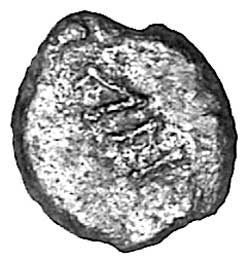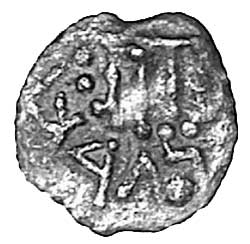View lot


Estimate $7,000
Bid at live.noble.com.au
PALESTINE, Judaea, Mattathias Antigonus, (40-37 B.C.), copper prutah, (1.28 grams), obv. seven branched memorah surrounded by inscription, [BACI**LEW*C] AN[TI**G*ONY], rev. Showbread Table, consisting of a flat board supported by four legs, with Paleo-Hebrew inscription [five letters visible of Mattathias name and title, 'Mattitah High Priest'], (S.6107 [p.561 and illustrated from same dies], H. 485 [38], AJC ZI cf.ZISA [same dies] and Addendum Z1a Pl.24 [same dies], Meshorer 36A, Bank of Israel, Kindler 24 [same dies, with similar lack of menorah on the coin]). Off centred on the obverse and reverse as usual with only a trace of menorah visible, but with complete showbread table, otherwise with a dark tone, sharply struck, nearly very fine and of greatest rarity.
Of great rarity (with probably less than twenty known). This is the first and only representation showing the two most prestigious cult vessels of the Temple on an ancient Jewish coin, the Menorah (candelabrum) on one side and the Showbread Table on the other, being the original ones as seen prior to the Temple destruction in 70 A.D. It is, indeed, the earliest datable object picturing these articles in Jewish art. This coin is unique in all of ancient Jewish coinage, in that it shows articles used in Temple worship. It was produced differently from the bulk of the coins of Antigonus, and also the weight standard appears to be much lighter. The golden table (Showbread Table) was placed near the Menorah and with the Menorah, was companion article in services. It is quite likely that the Showbread Table does not receive the veneration that the Menorah does in modern times, because of the importance of bread and the Lord's Table in Christian services. The rule of Mattathias as High Priest commenced in 40 B.C. and by 37 B.C. Herod I, threatened to end five generations of Hasmonean rule. The Jewish population was afraid of the turn of events and Antigonus issued this unique coin type, during the siege of Jerusalem. The depiction of these objects is forbidden in the Babylonian Talmud; 'A man may not make a house after the design of the Temple, a courtyard after the design of the Temple, a table after the design of the table (in the Temple), or a candelabrum after the design of the candelabrum (in the Temple).' Interestingly, this paragraph singles out the Menorah and the Showbread Table from all the objects in the Temple and forbids their reproduction. It is also interesting that they are mentioned in a single category. Meshorer observes that it was not until the third century A.D. that the Menorah became the most important Jewish symbol. 'Thus the depiction of the image on this coin minted as early as the reign of Antigonus is a remarkable and daring phenomenon, which must be seen in the context of the contemporary historical circumstances. Antigonus may have depicted these objects on his coins both to encourage his supporters and to remind the people of their duty to preserve the sanctity of the Temple (and its High Priest) from the foreigners.' This specimen, the most sought after of Jewish coins rarely appears on the market. Curiously it is the most expensive object in copper for any known artifact, by weight. The most recent sale examples are the Bromberg specimen (Superior, Dec. 5, 1991, lot 19, which appears to be from the same dies as this specimen and realised US$27,500), and the Abramowitz Family Collection specimen (Superior Dec. 8, 1993, lot 12. which realised $31,900). While this example is off centre and shows almost no representation of the Menorah it has as fine a Showbread Table as any on all the known specimens.
Estimate / sale price does not include buyer's premium (currently 22% including GST) which is added to hammer price. All bids are executed on the understanding that the Terms & Conditions of sale have been read and accepted. For information on grading and estimates please refer to the Buying at Auction advice.
Quick find
View a lot by number and sale.
Adjacent lots
Lot 2239
PALESTINE, Judaea, Mattathias Antigonus, (40-37 B.C.), copper multiple (four) prutah, (7.79 grams), obv. ivy wreath ...
Estimate $300
Lot 2240
PALESTINE, Judaea, Mattathias Antigonus, (40-37 B.C.), copper prutah, obv. wreath and inscription, rev. double cornucopiae ...
Estimate $40
Lot 2241 This lot
PALESTINE, Judaea, Mattathias Antigonus, (40-37 B.C.), copper prutah, (1.28 grams), obv. seven branched memorah surrounded ...
Estimate $7,000
Lot 2242
PALESTINE, Judaea, King Herod I (The great), (37 - 4 B.C.), issue of year 3 ...
Estimate $150
Lot 2243
PALESTINE, Judaea, Herod I, (40 - 4 B.C.), copper two prutah, AE 19, (2.7 grams), ...
Estimate $120